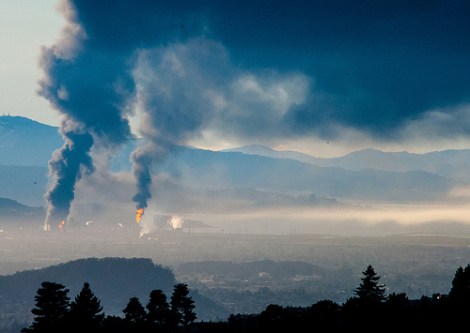After one of the distillation units at its Richmond, Calif., facility exploded last month, Chevron went into image rehabilitation mode. After this morning’s San Francisco Chronicle story, the company’s going to have to work a lot harder.
Federal authorities have opened a criminal investigation of Chevron after discovering that the company detoured pollutants around monitoring equipment at its Richmond refinery for four years and burned them off into the atmosphere, in possible violation of a federal court order, The Chronicle has learned.
Secure · Tax deductible · Takes 45 SecondsSecure · Tax deductible · Takes 45 SecondsAir quality officials say Chevron fashioned a pipe inside its refinery that routed hydrocarbon gases around monitoring equipment and allowed them to be burned off without officials knowing about it. Some of the gases escaped into the air, but because the company didn’t record them, investigators have no way of being certain of the level of pollution exposure to thousands of people who live downwind from the plant.
According to investigators from the Bay Area Air Quality Management District (BAAQMD), Chevron ran 100 feet of three-inch pipe from a processing system to a flare tower (used for combusting waste gasses), in the process shunting the gas around a tool meant to monitor waste gas production. The company claimed that the pipe was used to “balance pressure.” The BAAQMD “could find no legitimate use for it.”

The August refinery explosion. (Photo by stephen schiller.)
The shunt isn’t new — it’s been in place for years, possibly since the company was cited in 2005 for violations of clean air rules due to excess gas flaring. The monitor that the Chevron plant bypassed was one resulting from the 2005 action.
In some ways, last month’s refinery explosion was better for the people of Richmond than this bypass. After the explosion, some 14,000 people sought medical attention due to air quality problems. For years, Chevron was releasing unmonitored quantities of pollutants, primarily sulfur dioxide, quite possibly having a significant impact on the health of nearby residents.
Over the last month I’ve received several press releases from Chevron touting its partnerships with municipalities in California. (One lauds “Chevron Energy Solutions” as “one of the largest installers of solar power in the U.S. public sector;” another, as “one of the largest installers of solar power in the U.S. education market.” Even Chevron knows that turning black muck into gasoline is never a crowd-pleaser.) The focus on Chevron’s partnership with cities is an obvious attempt to combat post-explosion critiques (like this one) of the damage the company’s pollution does to the community.
Chevron Energy Solutions likes to point at the ways in which it works to improve communities. But if this report from the Chronicle is correct, it’s also happy to make sure that it’s hard or impossible for anyone to point at its pollution.



